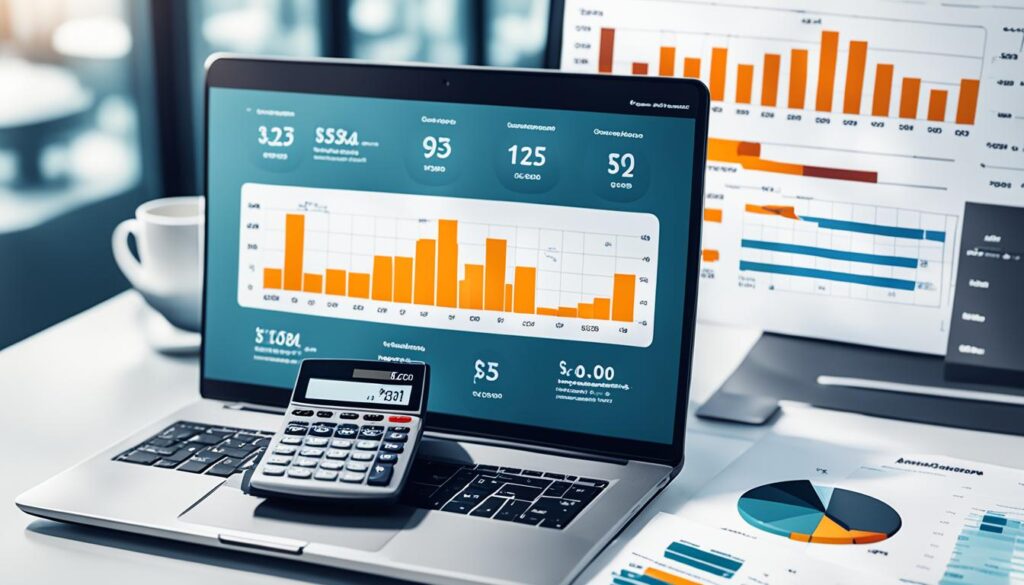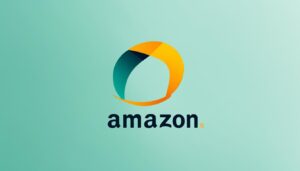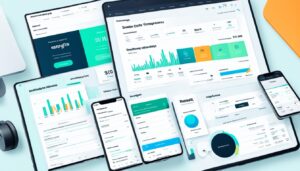Welcome to our guide on how to maximize your earnings as an Amazon seller through the use of Amazon sales profit calculators. These valuable tools allow you to analyze your return on investment (ROI) and evaluate the profitability of your Amazon FBA business. By understanding and optimizing these key metrics, you can make informed decisions that will help you increase your profits and achieve long-term success on the Amazon platform.
Calculating your ROI and assessing your business’s profitability are essential steps in growing your Amazon sales. With the help of Amazon sales profit calculators, you can analyze various factors such as product costs, selling prices, shipping fees, and Amazon fees to strategize and maximize your profits. These calculators provide valuable insights that can significantly impact your decision-making process in terms of pricing strategies, product selection, and overall business management.
Key Takeaways:
- Amazon sales profit calculators allow sellers to assess their ROI and optimize profitability.
- Understanding your Amazon ROI is crucial for assessing the profitability of your business.
- Evaluating the profitability of your Amazon FBA business is essential for making informed decisions.
- Understanding Amazon selling fees is important for accurately assessing profitability.
- Optimizing pricing strategies is key to maximizing profits as an Amazon seller.
Understanding Your Amazon ROI
Calculating your Amazon ROI is essential for assessing the profitability of your business. In order to determine your Return on Investment (ROI), you need to consider various factors such as product costs, Amazon fees, and advertising expenses. This evaluation allows you to understand how effectively your resources are being utilized and identify areas where improvements can be made.
Monitoring expenses is crucial for maintaining a healthy ROI. By keeping a close eye on your costs, you can identify areas of inefficiency or overspending. This knowledge empowers you to make informed decisions on budget allocation and prioritize investments that generate the highest returns.
Working towards increasing sales plays a key role in maximizing your Amazon ROI. Optimizing your product listings and conducting thorough keyword research can significantly boost your visibility and attract more potential customers. Additionally, implementing effective advertising strategies, such as sponsored product campaigns or targeted promotions, can help drive conversions and increase your sales volume.
“Continuous improvement is the key to maintaining a healthy ROI. By regularly analyzing your metrics and making data-driven decisions, you can adapt to market trends, optimize profitability, and stay ahead of the competition.”
Evaluating your Amazon business profitability is an ongoing process. It requires consistent monitoring, analysis, and adjustment to ensure sustainable growth. By calculating your ROI, monitoring your expenses, and focusing on strategies to increase sales, you can optimize your Amazon business profitability and achieve long-term success.
Example Calculation:
To better understand how calculating your Amazon ROI works, consider the following example:
| Product | Cost | Selling Price | Amazon Fees | Advertising Expenses | ROI |
|---|---|---|---|---|---|
| Product A | $10 | $30 | $5 | $2 | 130% |
| Product B | $15 | $40 | $6 | $3 | 137% |
| Product C | $20 | $50 | $7 | $4 | 135% |
The table above showcases the ROI calculations for three different products. By subtracting the costs (including Amazon fees and advertising expenses) from the selling price and dividing the result by the cost, we can determine the ROI percentage for each product. In this example, all three products show a healthy ROI, which indicates profitability.
By conducting similar calculations for your own products, you can gain valuable insights into the profitability of your Amazon business and make data-driven decisions that drive growth and success.
Understanding and optimizing your Amazon ROI is crucial for the success of your business. By considering factors such as product costs, Amazon fees, and advertising expenses, you can make informed decisions to maximize your profitability. Monitoring expenses and working towards increasing sales through optimized product listings, keyword research, and effective advertising strategies are key to maintaining a healthy ROI.
Evaluating FBA Profitability
Evaluating the profitability of your Amazon FBA business is crucial. As a seller, you need to understand the financial impact of your operations and make strategic decisions to maximize your earnings. This is where the FBA profitability analysis comes into play. By using tools like the FBA calculator, you can gain valuable insights into your net profit margins and determine the viability of selling specific products.
When evaluating FBA profitability, it’s essential to consider all the costs associated with your business. These include the product price, FBA fees, and shipping costs. By factoring in these expenses, you can calculate your net profit margin and assess whether your current pricing strategy is optimal.
Here’s an example:
Product Price: $20
FBA Fees: $5
Shipping Costs: $2
Using the FBA calculator, you can calculate the total selling costs, which in this case would be $7 (FBA fees + shipping costs). Subtracting this from the product price, you get the net profit per unit, which in this case is $13. This information allows you to analyze the profitability of selling a specific product and make informed pricing decisions that maximize your earnings.
To further enhance your FBA profitability, it’s crucial to identify cost-saving opportunities. Analyzing your expenses can help you find areas where you can reduce costs and increase your profit margins. The FBA calculator is a valuable tool for performing “what-if” scenarios and exploring different pricing strategies to optimize your profitability.
For a more comprehensive view of your FBA profitability, you can utilize the following table:
| Product | Product Price | FBA Fees | Shipping Costs | Total Costs | Net Profit per Unit |
|---|---|---|---|---|---|
| Product A | $20 | $5 | $2 | $7 | $13 |
| Product B | $25 | $6 | $3 | $9 | $16 |
| Product C | $15 | $4 | $1 | $5 | $10 |
By regularly evaluating your FBA profitability and making data-driven decisions, you can optimize your Amazon business to achieve higher net profit margins and ultimately increase your overall earnings.
Understanding Amazon Selling Fees
When selling products on Amazon, it’s crucial to have a clear understanding of the fees involved to accurately assess your profitability. As an Amazon seller, you will encounter several types of fees, including referral fees, FBA fees, storage fees, and fulfillment costs. Let’s take a closer look at each of these fees and how they impact your profit margins.
Referral Fees
Referral fees are the fees that Amazon charges for each item sold on their platform. These fees vary based on the product category and are a percentage of the item’s total sale price. It’s important to factor in these referral fees when calculating your product’s pricing strategy to ensure you are achieving the desired profit margins.
FBA Fees
FBA (Fulfillment by Amazon) fees are applicable to sellers who choose to utilize Amazon’s storage and shipping services. With FBA, Amazon takes care of storing your products in their warehouses, packaging them, and delivering them to customers. In return for this convenience, sellers are charged fees based on storage duration and the size and weight of their items. It’s essential to consider these FBA fees when deciding whether to use FBA for your products.
Storage Fees
Storage fees are incurred by sellers who store their inventory in Amazon’s fulfillment centers for an extended period. These fees are charged based on the amount of space your products occupy in the warehouse and can vary depending on the time of year and demand. Proper inventory management and forecasting can help minimize storage fees and optimize your profit margins.
Fulfillment Costs
In addition to referral, FBA, and storage fees, sellers should also consider fulfillment costs when determining their overall expenses. Fulfillment costs include shipping charges, packaging materials, and any additional services required to prepare and deliver your products to customers. By accurately calculating fulfillment costs, sellers can better gauge the impact on their profitability.
By factoring in all these Amazon selling fees into your calculations, you will gain a comprehensive understanding of the costs associated with your products. This knowledge allows you to make informed decisions regarding pricing strategies, inventory management, and fulfillment options to optimize your profit margins.
Optimizing Pricing Strategies
Proper pricing is essential for optimizing your Amazon selling strategy. Setting the right prices can help attract customers, increase sales, and maximize your profit margins. To ensure effective pricing strategies, consider using the Amazon revenue calculator and regularly monitoring your gross margins and monthly sales.
Here are some key steps to optimize your pricing strategies on Amazon:
1. Utilize the Amazon Revenue Calculator
The Amazon revenue calculator is a valuable tool that helps estimate your sales performance based on your current product prices. By inputting your product costs and pricing strategies, you can get insights into your potential revenue and profit margins. This information allows you to make informed decisions about adjusting your prices to maximize profitability.
2. Monitor Gross Margins
Regularly monitoring your gross margins is crucial for understanding your profit margins. Calculate your gross margin by subtracting the cost of goods sold (COGS) from your product’s selling price. Analyzing your gross margins can help you identify any inefficiencies in your pricing or cost structure, allowing you to make necessary adjustments to improve profitability.
3. Analyze Monthly Sales Data
Tracking your monthly sales data provides valuable insights into your pricing strategies’ effectiveness. Analyze your sales volume and revenue trends to identify any patterns or fluctuations. This analysis can help you identify the optimal price points that maximize sales while maintaining satisfactory profit margins.
4. Consider Competitor Pricing
Understanding your competitors’ pricing strategies can provide valuable market insights. Research similar products and analyze their pricing to ensure your prices are competitive. However, be mindful of your own costs and profit margins when setting prices, as blindly matching your competitors’ prices may negatively impact your profits.
When launching new products, consider factors such as the product niche and demand, carefully selecting price points that align with your target market’s expectations. Efficient inventory management is also critical to ensure you maintain a healthy profit margin while avoiding stockouts or excessive inventory storage costs.
“Proper pricing is a balancing act that requires thorough analysis of market demand, competitor pricing, and your own cost structure. By utilizing strategic pricing strategies and continuously analyzing your performance, you can optimize your prices for maximum profitability.” – Amazon Seller
Remember, pricing is not a one-time decision. Regularly evaluate and adjust your prices based on market conditions, performance data, and customer feedback. By constantly refining your pricing strategies, you can find the sweet spot that drives sales while maximizing your profit margin.

Monitoring Monthly Profit
Monitoring your monthly profit is crucial for effectively managing your Amazon FBA business. By keeping a close eye on your finances, you can make informed decisions and optimize your earning potential. One valuable tool that can assist you in this endeavor is the Amazon Revenue Calculator.
The Amazon Revenue Calculator is a powerful tool that allows you to calculate costs, profits, and margins. It provides valuable insights into your business’s financial health and helps you identify areas for improvement. By inputting your product costs, selling prices, and shipping fees, the calculator provides a clear overview of your monthly profit.
In addition to monitoring your profit, it is also essential to track your Return on Assets (ROA). ROA is a vital metric that measures the efficiency of your business in generating profits relative to your assets. By analyzing your ROA, you can gain valuable insights into how effectively you are utilizing your resources.
Evaluating your monthly profit and monitoring your ROA allows you to make data-driven decisions. You can identify what products or strategies are yielding the highest returns and allocate your resources accordingly. This can help you optimize your business’s profitability and achieve long-term success on Amazon.
Benefits of Monitoring Monthly Profit and ROA:
- Identify which products or categories generate the highest profits
- Optimize pricing strategies to maximize profit margins
- Make informed decisions regarding inventory management
- Identify cost-saving opportunities and reduce expenses
- Track the effectiveness of your marketing and advertising efforts
By regularly monitoring your monthly profit and ROA, you can stay ahead of the competition and ensure the long-term success of your Amazon FBA business.
| Key Metrics | Definition |
|---|---|
| Monthly Profit | The amount of profit generated in a specific month |
| Return on Assets (ROA) | A financial ratio that measures the efficiency of a business in generating profits relative to its assets |
| Amazon Revenue Calculator | A tool that helps sellers calculate costs, profits, and margins |
Monitoring your monthly profit and ROA is essential for optimizing your Amazon FBA business. By leveraging tools like the Amazon Revenue Calculator and gaining insights from key metrics, you can make informed decisions and maximize your earning potential.
Estimating Amazon Sales
Estimating Amazon sales is a critical step for sellers aiming to expand their product catalog or assess the potential sales growth of existing products. By accurately predicting sales volume and revenue, sellers can make informed business decisions and optimize their earning potential. To facilitate this process, several tools and resources are available, including the Amazon Revenue Calculator and third-party tools like Jungle Scout and Helium10.
The Amazon Revenue Calculator is a powerful tool provided by Amazon itself. With real-time data, it allows sellers to estimate sales volume and revenue based on product information, fees, and other key factors. By inputting relevant data, sellers can determine their potential profit margins and identify areas for improvement in their pricing and sales strategies.
In addition to the Amazon Revenue Calculator, third-party tools like Jungle Scout and Helium10 provide valuable insights and data for estimating Amazon sales. These tools offer comprehensive analytics, market research features, and sales estimation capabilities. By leveraging these resources, sellers gain a competitive edge in understanding market trends, opportunities, and potential sales performance.
Exclusive Amazon Tools for Sales Estimation
Amazon also offers exclusive tools to help sellers estimate their sales potential and identify business opportunities. Two notable examples are:
- Growth Opportunities: This tool provides valuable insights into high-potential product categories and niches, allowing sellers to identify areas with high demand and limited competition. By leveraging this data, sellers can capitalize on market gaps and plan their product expansion strategies strategically.
- Product Opportunity Explorer: This tool provides sellers with product performance data, including sales volume, revenue, and reviews in a specific category. By analyzing this data, sellers can assess product viability and identify potential profitable products to add to their inventory.
By using a combination of the Amazon Revenue Calculator, third-party tools, and exclusive Amazon resources, sellers can make informed decisions regarding their product catalog, pricing strategies, and sales optimization efforts.
| Tools | Features | Benefits |
|---|---|---|
| Fusion Analyzer Chrome Extension | – Real-time sales estimation – Accurate revenue calculation – Insights into profit margins |
– Plan pricing strategies effectively – Identify profitable products – Optimize profitability |
| Jungle Scout | – Comprehensive market research – Sales estimation capabilities – Competitor analysis |
– Identify market trends and gaps – Make data-driven decisions – Stay ahead of the competition |
| Helium10 | – Robust analytics – Sales estimation features – Keyword research tools |
– Understand customer behavior – Optimize product listings – Drive targeted traffic |
Analyzing Costs vs. Profit
Accurately calculating Amazon FBA profits requires a thorough analysis of costs versus profit. As an Amazon seller, it’s essential to consider various expenses, including FBA seller fees, storage costs, transportation fees, and other associated costs.
One effective tool to estimate your seller fees, revenue, and profit is the Amazon FBA calculator. By inputting key data such as product price, shipping costs, and fulfillment fees, you can obtain an accurate calculation of your expected profit. This allows you to make informed business decisions and optimize your selling strategy.
Reducing costs is another crucial factor in maximizing your profit margins. By streamlining your operations, optimizing packaging, and minimizing returns, you can minimize expenses and increase your overall profitability.
To provide a visual representation of how costs impact profits, here is a table showcasing a hypothetical revenue calculation for an Amazon FBA seller:
| Product Revenue | $10,000 |
|---|---|
| FBA Seller Fees | $1,500 |
| Storage Costs | $500 |
| Transportation Fees | $200 |
| Other Expenses | $300 |
| Net Profit | $7,500 |
This table clearly demonstrates how seller fees, storage costs, transportation fees, and other expenses impact the net profit of an Amazon FBA seller. By accurately calculating these costs and optimizing them, you can effectively increase your profit margins and improve the overall profitability of your Amazon business.
Amazon Sales Profit Calculators Recap
Maximizing profits on Amazon requires careful calculation of costs, revenue, and profit margins. Sellers should continuously evaluate and adjust their pricing strategies, monitor expenses, and optimize campaigns to maximize profitability. Accurate calculation of profit, analyzing market demand, restocking inventory, and reducing overhead costs play a crucial role in maximizing earnings. By making informed business decisions based on reliable data, sellers can optimize their Amazon sales and boost their profit margins.
To achieve Amazon profit maximization, sellers need to stay vigilant in understanding market dynamics, tracking expenses, and making strategic choices. It’s important to regularly evaluate sales and revenue, ensuring they are in line with business goals. By monitoring expenses such as Amazon seller fees, storage costs, and transportation fees, sellers can identify areas for cost optimization and take appropriate actions to increase profitability.
Optimizing profitability on Amazon also involves making data-driven decisions. Analyzing market trends, customer behavior, and competitors’ pricing can provide valuable insights to sellers. Understanding which products have the highest demand and adjusting inventory levels accordingly can help maximize sales potential. Additionally, reducing overhead costs through efficient operations and streamlined processes will contribute to higher profit margins.
Successful sellers on Amazon know that business decisions should be based on accurate calculations, market analysis, and a deep understanding of their customers. By leveraging tools like revenue calculators, sales estimators, and ROI calculators, sellers can make informed choices that lead to enhanced profitability. Optimizing product listings, advertising campaigns, and fulfillment strategies, along with continuously monitoring sales performance, can help sellers stay competitive, increase their business revenue, and achieve their profit optimization goals on Amazon.
FAQ
What is an Amazon ROI calculator, and why is it important?
An Amazon ROI calculator is a tool that allows sellers to assess their return on investment. It is important because it helps sellers strategize to maximize profits by monitoring expenses and benchmarking ROI against industry standards.
How do I calculate my Amazon ROI?
To calculate your Amazon ROI, you need to consider factors such as product costs, Amazon fees, and advertising expenses. By monitoring expenses and working towards increasing sales through optimized product listings and effective advertising strategies, you can maintain a healthy ROI.
How do I evaluate the profitability of my Amazon FBA business?
You can evaluate the profitability of your Amazon FBA business by analyzing estimated sales data using tools like the Amazon FBA sales estimator. Understanding net profit margins by factoring in costs such as product price, FBA fees, and shipping costs is essential for determining the viability of selling specific products.
What fees are involved in selling on Amazon?
Sellers are subject to referral fees, which vary by product category, and FBA fees for utilizing Amazon’s fulfillment services. Storage fees and fulfillment costs are additional expenses that impact profit margins. It is important to factor these fees into your Amazon ROI calculations to accurately assess profitability.
How can I optimize my pricing strategy on Amazon?
Using a revenue calculator can help estimate sales performance based on current prices. Regularly monitoring gross margins and monthly sales can help identify areas for improvement. When launching new products, selecting the right niche and efficiently managing inventory are key factors to consider.
Why is monitoring monthly profit important for managing an Amazon FBA business?
Monitoring monthly profit allows sellers to make informed decisions and optimize their earning potential. Tools like the Amazon Revenue Calculator can help calculate costs, profits, and margins. Tracking return on assets (ROA) provides insights into the efficiency of your business.
How can I estimate my Amazon sales?
You can estimate your Amazon sales using tools like the Amazon Revenue Calculator and third-party tools like Jungle Scout and Helium10. These tools provide data on estimated sales volume and revenue based on real-time data. Exclusive Amazon tools like Growth Opportunities and Product Opportunity Explorer can also help identify business opportunities and estimate sales potential.
How can I analyze costs vs. profit on Amazon?
Sellers must consider FBA fees, storage costs, transportation fees, and other associated expenses when analyzing costs vs. profit. The Amazon FBA calculator is a useful tool for estimating seller fees, revenue, and profit. Streamlining costs, optimizing packaging, and reducing returns can further increase profit margins.
How can I maximize profits on Amazon?
Maximizing profits on Amazon requires careful calculation of costs, revenue, and profit margins. Sellers should continuously evaluate and adjust their pricing strategies, monitor expenses, and optimize campaigns to maximize profitability. Accurate calculation of profit, analyzing market demand, restocking inventory, and reducing overhead costs play a crucial role in maximizing earnings.




